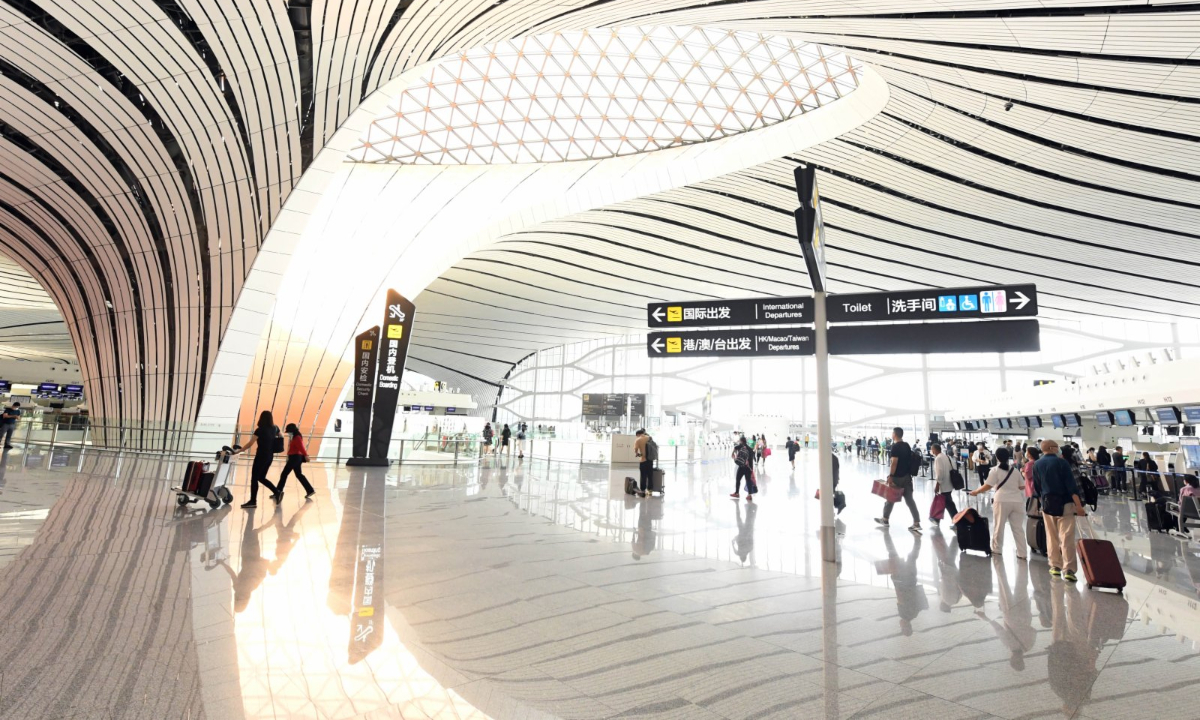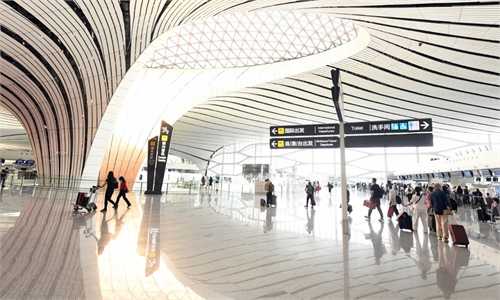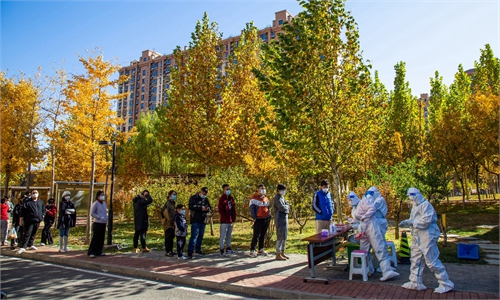Multiple provinces across China further detail implementation of optimized anti-COVID measures

Beijing Daxing International Airport Photo: Xinhua
Multiple provincial-level regions across China have further deployed, researched, optimized and detailed the implementation of anti-epidemic measures following the roll-out of 20 measures to optimize COVID-19 response on Friday, the country's latest move in scientific and precise epidemic control and prevention work to fight the COVID-19 epidemic amid a global resurgence.
It cannot be ruled out that further optimization and adjustment of Chinese quarantine measures will be made as the SAR-CoV-2 is continuing to mutate, understanding of this disease is deepened, and the entire situation of the epidemic at home and abroad is changing, Chinese Center for Disease Control and Prevention said during a press briefing by the Joint Prevention and Control Mechanism of the State Council on Saturday.
Shanghai has decreased the frequency of nucleic acid testing for local primary and middle school students at school to three times every week from five times a week, as well as rolled out other more precise epidemic control and prevention measures on Sunday in accordance with the 20 optimized measures released by the Joint Prevention and Control Mechanism of the State Council on Friday, according to the official WeChat account of the city.
The city that registered one new confirmed local patient and nine new asymptomatic carriers on Saturday with all the infections discovered under quarantine will cancel regular citywide nucleic acid testing, and the all-member testing will only be carried out when the origin and the transmission chains of the infections are unclear or the virus has been spreading for a long while with uncertain and untraceable infections.
China registered a total of 1,675 new local confirmed patients and 13,086 new asymptomatic carriers on Saturday, one day after the roll-out of 20 optimized measures including shortened quarantine periods for international arrivals and cancelation of circuit breakers for inbound flights, no more requirement on the screening of close contacts of close contacts, or secondary contacts, and that the categories of COVID-19 risk areas will be adjusted from three categories of "high," "medium," and "low" to just two categories of "high" and "low" to minimize the number of people that may be subject to community lockdowns or health monitoring.
China's National Health Commission (NHC) further explained and answered questions related to the 20 measures concerned by the public on its official website on Sunday.
As the SAR-CoV-2 is continuing to mutate, the global epidemic is still spreading, and new flare-ups are constantly emerging in some domestic places, the scope and scale of the epidemic are likely to further expand in the country when entering the winter and spring seasons, since China has a large population and a large number of vulnerable groups, NHC said in a statement.
According to NHC, infected people's workplaces and activity venues with high risk of epidemic transmission will be designated as "high" risk areas, which are designated generally based on units or buildings to minimize the control on the range and personnel.
Since the latent Omicron variants are spreading faster, the epidemic prevention at venues including schools, nursing homes, psychiatric hospitals and enterprises will be strengthened.
To ensure the implementation of the optimized measures and curbing local government ramping up COVID response measures, excessive policy steps such as random suspension of classes, operation and production, and adoption of static management for a long time, will be prohibited.
Such behaviors will be made public and offenders will be held accountable in accordance with the law and regulations if serious consequences are caused.
A task force dedicated to resolving issues related to local governments ratcheting up virus-containment measures or applying rigid steps have been set up across the country, according to NHC.
Apart from Shanghai, multiple places including Beijing, South China's Guangdong and Hainan provinces, Northwest China's Gansu and Qinghai provinces and Xinjiang Uygur Autonomous Region, North China's Inner Mongolia Autonomous Region, and East China's Jiangsu and Jiangxi provinces have also made swift adjustments for COVID-19 prevention and control measures after the 20 measures were released on Friday, local media reported.
Beijing authorities urged more precise measures to be taken on quarantine, transport, nucleic acid testing, flow of personnel, medical services, vaccination, in service enterprises and on campuses after the roll-out of the 20 measures on Friday.
Beijing municipal government officials on Saturday announced the launch of a special relief mechanism, effective from Saturday, for people who have been stranded outside Beijing for extended periods, vowing to help address situations for people who had visited high risk areas outside Beijing.
The latest Omicron-hit Guangdong also vowed on Friday to strengthen scientific precise prevention and continue to improve the effectiveness of the prevention and control work, resolutely preventing problems such as simplification, one-size-fits-all, and ratcheting up virus-containment measures.
The province facing a grim epidemic control situation with 247 new local confirmed patients and 3,541 asymptomatic infections registered on Saturday vowed to focus its efforts on the battle against the epidemic and curb the flare-up as soon as possible.
In response to the adjusted policies, Chinese embassies in multiple countries such as Singapore, Canada, the US and Sri Lanka released notices on Sunday on the adjustments of policies on pre-trip nucleic acid testing for people going to China.
Only one nucleic acid test within 48 hours before they get on board will be needed and they can apply for a health code with the negative results of the tests. Before the adjustment on the policy, two negative results of nucleic acid tests were needed by inbound travelers to China.
China's NHC reiterated on Saturday that the 20 measures are designed to optimize the country's ninth edition of diagnostic and treatment protocols for COVID-19, to make the implementation of the measures more science-based and precise, noting that strict epidemic prevention and control must be combined with optimized measures, and that "strenuous efforts must be put on both."
"They certainly do not mean we can slacken our response or even simply end COVID restrictions and lie flat," Mi Feng, spokesperson from the NHC, said at a press conference held by the State Council Joint Prevention and Control Mechanism against COVID-19 on Saturday.
Through a series of measures, including strengthening policy interpretation and training, the authorities will promote the implementation of the 20 optimized measures, Mi said.
Global Times


